This comprehensive and beautifully illustrated guide unveils the most vibrant and distinctive blue birds that grace the skies and wetlands of Louisiana. From the striking Eastern Bluebird to the elusive Cerulean Warbler, each bird is showcased with stunning photographs and insightful descriptions that will not only help you identify them but also understand their habits and habitats.
Get ready to embark on a colorful journey through the bayous and beyond with your FREE photo guide. Your adventure into the world of blue birds in Louisiana starts here!
Blue Birds Found In Louisiana
The diverse range of birds found in Louisiana can be attributed to its unique geographic characteristics. The state is a blend of various habitats, ranging from coastal marshlands and swamps to pine forests and uplands.
This vast range of habitats provides a perfect home for a diverse range of birds. The Gulf Coast region serves as an essential migratory route, which means that Louisiana plays a vital role as a stopover point for migratory birds traveling between North and South America.
Barn Swallow


| Feature | Measurement |
|---|---|
| Scientific Name | Hirundo rustica |
| Length | 6.5–7.5 in |
| Wingspan | 12.5–13.5 in |
| Weight | 16–22 g |
The Barn Swallow is a sleek, agile bird renowned for its graceful flight patterns and iconic forked tail, often seen darting over fields and water bodies in search of flying insects.
Appearance: Barn Swallows have deep blue, almost iridescent, upperparts and a rufous to tawny underbelly. Their distinctively forked tail and long wings give them a streamlined look. Both males and females have a similar appearance, though males often exhibit slightly brighter colors and a deeper fork in the tail.
Diet: Barn Swallows feed primarily on flying insects, which they catch in mid-air during their agile and acrobatic flights. Their diet includes flies, beetles, moths, and other small flying insects.
Reproduction: Barn Swallows are known for building their mud nests on man-made structures, particularly barns, bridges, and eaves. The nest is cup-shaped and made from mud pellets, often lined with feathers. The female lays a clutch of 4 to 6 eggs.
Eastern Bluebird
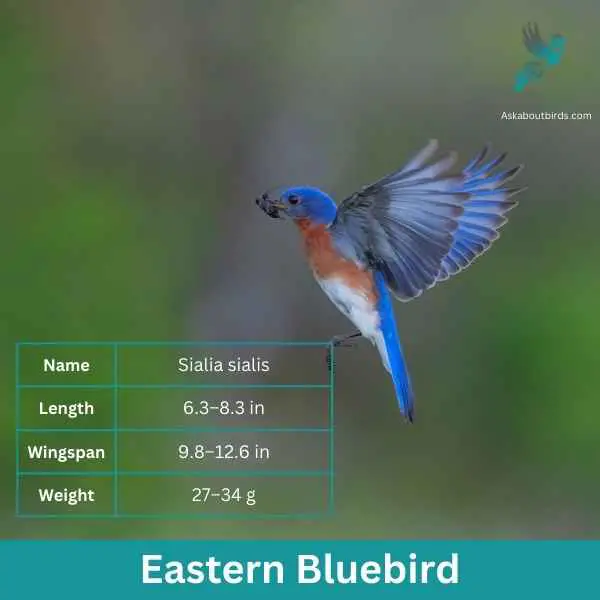
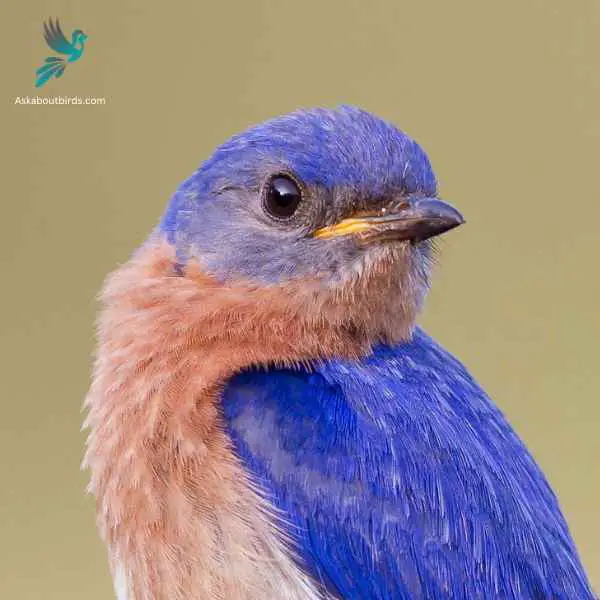
| Feature | Measurement |
|---|---|
| Scientific Name | Sialia sialis |
| Length | 6.3–8.3 in |
| Wingspan | 9.8–12.6 in |
| Weight | 27–34 g |
The Eastern Bluebird (Sialia sialis) is a small thrush found in open woodlands, farmlands, and orchards, and is recognized for its vibrant blue and red coloration. Male Eastern Bluebirds are dazzling with bright blue upperparts and a rusty or brick-red throat and breast, while females, though less colorful, still offer a similar pattern. The bird is native to North America and is commonly seen east of the Rockies, from Canada to the Gulf States and southeastern Arizona to Nicaragua.
Eastern Bluebirds feed on insects, wild fruit and berries. They have a gentle nature and are often seen perched alone or in small groups in the open, scanning the ground for prey. They are cavity nesters and will use old woodpecker holes or birdhouses if they are the right size.
Blue Jay

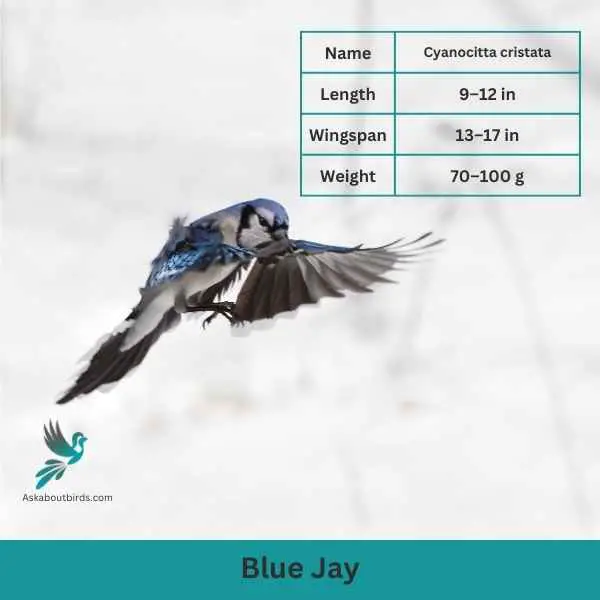
| Feature | Measurement |
|---|---|
| Scientific Name | Cyanocitta cristata |
| Length | 9–12 in |
| Wingspan | 13–17 in |
| Weight | 70–100 g |
The Blue Jay is a vibrant and easily recognized bird, known for its intelligence, distinctive calls, and bold behavior, commonly found throughout the eastern and central United States.
Appearance: The Blue Jay sports a striking blue upper body with white and black markings. Its face has a pronounced white patch with a black necklace that runs across the throat and around the head. The bird also features a pronounced blue crest, which can be raised or lowered, and its wings and tail are brightly colored with black bars and white tips.
Diet: Blue Jays are omnivores. Their diet consists primarily of seeds, nuts, especially acorns, fruits, and small insects. They’ve also been known to eat eggs or nestlings of other birds occasionally. Blue Jays often store food items in caches to eat later.
Reproduction: Blue Jays are monogamous birds that form long-lasting pair bonds. They typically build their nests in trees or large shrubs, constructing them from twigs, grass, and sometimes using mud as a binder. The female lays a clutch of 3 to 6 eggs, which are pale blue or sometimes white with brown speckles.
Tree Swallow
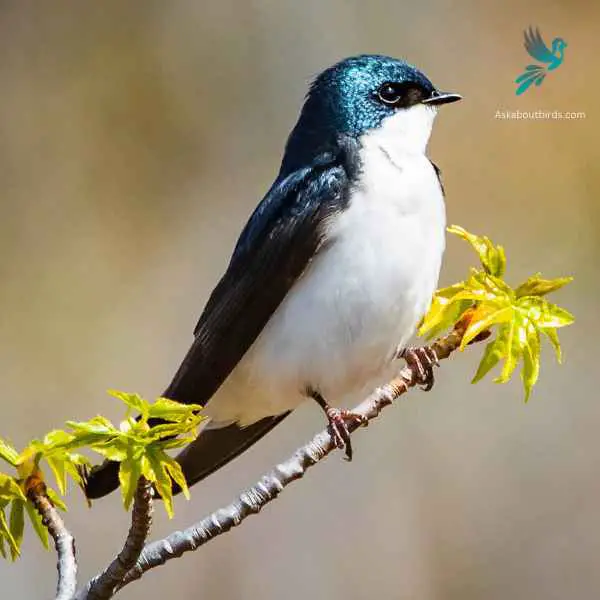
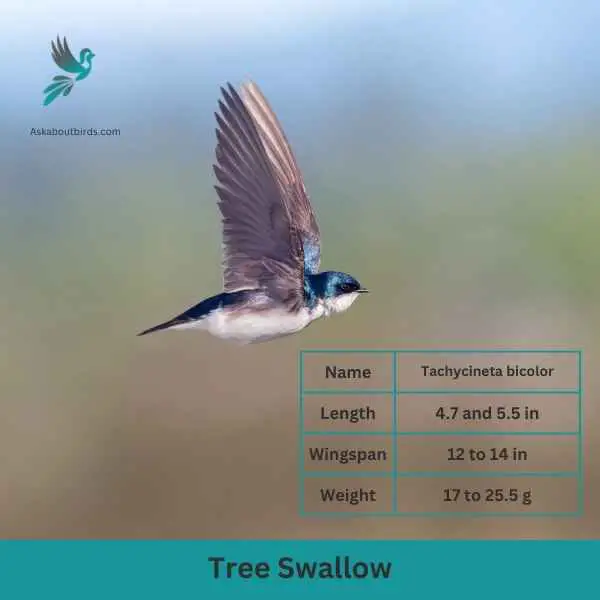
| Feature | Measurement |
|---|---|
| Scientific Name | Tachycineta bicolor |
| Length | 4.7 and 5.5 in |
| Wingspan | 12 to 14 in |
| Weight | 17 to 25.5 g |
The Tree Swallow is a graceful and agile bird, best recognized for its iridescent blue-green upperparts and sweeping flight patterns over open fields and water.
Appearance: The Tree Swallow is sleek with a streamlined body. The upperparts shine with a blue-green iridescence while the underparts are white. They possess long, pointed wings and a slightly forked tail, aiding in their agile flight.
Diet: Tree Swallows primarily feed on flying insects, skillfully catching them mid-air. During colder months when insects are scarce, they can switch to a diet of berries, particularly those of the bayberry, which other birds might find hard to digest.
Reproduction: Tree Swallows are cavity-nesters, typically choosing natural holes in trees or using bird boxes. They line their nests with feathers, creating a soft environment for the eggs. The female will lay a clutch of 4 to 7 white eggs.
Indigo Bunting


| Feature | Measurement |
|---|---|
| Scientific Name | Passerina cyanea |
| Length | 4.5–5.1 in |
| Wingspan | 7.1–9.1 in |
| Weight | 11.2–21.4 g |
The Indigo Bunting is a strikingly vibrant songbird, often hailed for its brilliant blue plumage and melodic song that graces woodlands and meadows during the warmer months.
Appearance: Males are renowned for their bright indigo blue feathers, which can appear darker in certain lights. Females and juveniles, on the other hand, are brown with subtle hints of blue on their wings and tail. The species lacks the vibrant streaking or spotting commonly found in many other songbirds.
Diet: Indigo Buntings primarily subsist on seeds, especially during non-breeding seasons. During the breeding season, they also consume a variety of insects such as beetles, caterpillars, and spiders, providing essential protein for their growing chicks.
Reproduction: Indigo Buntings build their nests close to the ground in shrubs or low tree branches. These nests, crafted meticulously with grasses and other plant materials, cradle clutches of typically 3 to 4 eggs. After hatching, the young are fed by both parents until they’re ready to fledge.
Purple Martin
Scientific Name: Progne subis
Length: 7.5-8.7 inches
Wingspan: 15.3-16.1 inches
Weight: 1.6-2.1 oz
The Purple Martin is North America’s largest swallow, known for its graceful flight patterns and communal nesting behavior.
Appearance: Male Purple Martins are almost entirely dark purple-blue with a glossy sheen, while females and juveniles are paler, featuring grayish underparts dark wings and a blueish-black upper body.
Diet: Purple Martins predominantly feed on flying insects, catching them skillfully in mid-air. Their diet consists of beetles, flies, moths, butterflies, dragonflies, and other airborne insects.
Reproduction: Purple Martins are famous for nesting in man-made structures, especially in the eastern parts of North America. These tiny birds also are colonial nesters, often occupying birdhouses with multiple compartments. The female typically lays a clutch of 4-6 white eggs.
Blue Grosbeak
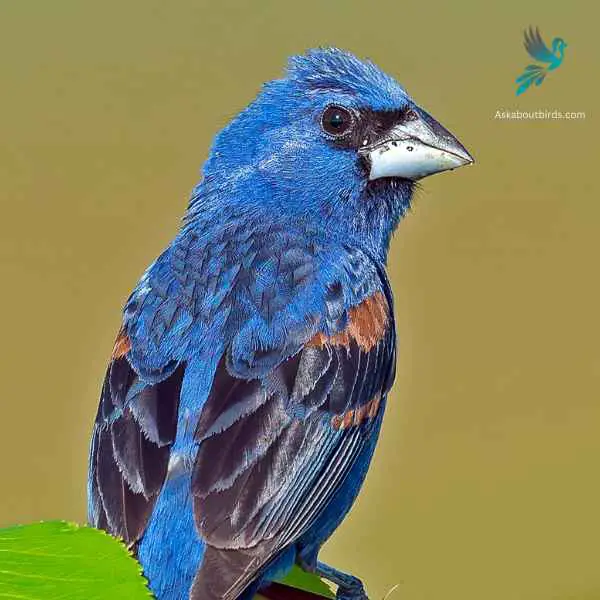

| Feature | Measurement |
|---|---|
| Scientific Name | Passerina caerulea |
| Length | 5.5 to 7.5 in |
| Wingspan | 10 to 11 in |
| Weight | 26 to 31.5 g |
The Blue Grosbeak is a medium-sized songbird found in North and Central America. The male Blue Grosbeak displays stunning plumage with deep blue feathers on its body and head, while the female has more subdued brownish tones. Both sexes have a thick, conical bill, which gives them their name “grosbeak,” meaning large beak.
These birds prefer open habitats such as grasslands, brushy areas, and woodland edges. Blue Grosbeaks are known for their melodious songs, which consist of a series of rich and varied notes. They primarily feed on seeds and insects, using their strong beaks to crack open seeds and forage on the ground or in low vegetation.
Belted Kingfisher

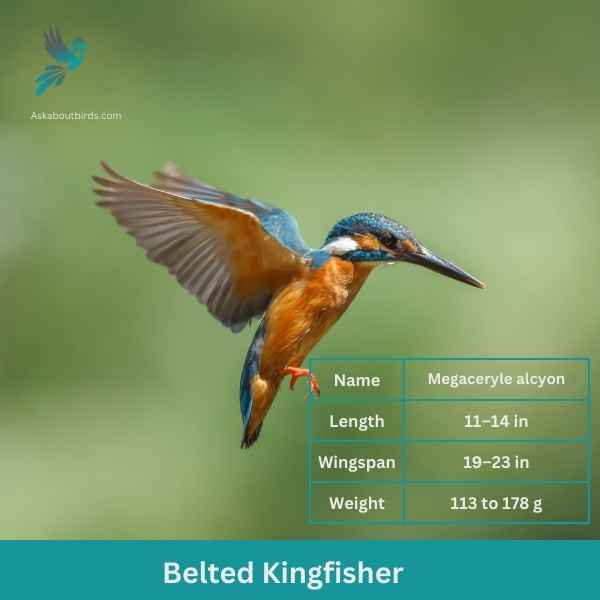
| Feature | Measurement |
|---|---|
| Scientific Name | Megaceryle alcyon |
| Length | 11–14 in |
| Wingspan | 19–23 in |
| Weight | 113 to 178 g |
The Belted Kingfisher is a distinctive and easily recognizable bird, frequently observed near water bodies, where it can be seen diving headfirst to catch prey.
Appearance: Sporting a prominent crest, the Belted Kingfisher has a slate blue-gray upper body and white underparts. Males possess a single blue band across their white chests, while females have an additional rufous band, making them one of the few bird species where females are more brightly colored than males. Their bill is long, sharp, and dagger-like.
Diet: As expert fishers, Belted Kingfishers mainly prey on small fish, but they’ll also consume crustaceans, insects, and amphibians. They’re known for their hunting tactic of hovering over water, spotting their prey, and then diving swiftly to snatch it.
Reproduction: Belted Kingfishers nest in burrows which they excavate in sandy or earthen banks, usually adjacent to water. The tunnel can be anywhere from 3 to 6 feet long, ending in a chamber. Within this chamber, the female lays a clutch of 5 to 8 white eggs.
Northern Parula
Scientific Name: Setophaga americana
Length: 4.3-4.7 inches
Wingspan: 6.3-7.1 inches
Weight: 0.2-0.4 oz
The Northern Parula is a small warbler recognized for its vibrant coloration and melodic song.
Appearance: The Northern Parula displays a bluish-gray plumage on its upperparts and a yellowish chest with a distinctive dark band. Males often have a brighter appearance, with striking blue feathers on the head blue wings and back.
Diet: Northern Parulas mainly feed on insects and spiders. They are adept foragers, often flitting through foliage to pluck their prey from leaves, branches, or even in mid-air.
Reproduction: Northern Parulas create pendant-shaped nests, often constructed from mosses and lichens. These nests are typically located high in trees. The female lays a clutch of 3-7 eggs, which are white with brown markings.
Cerulean Warbler
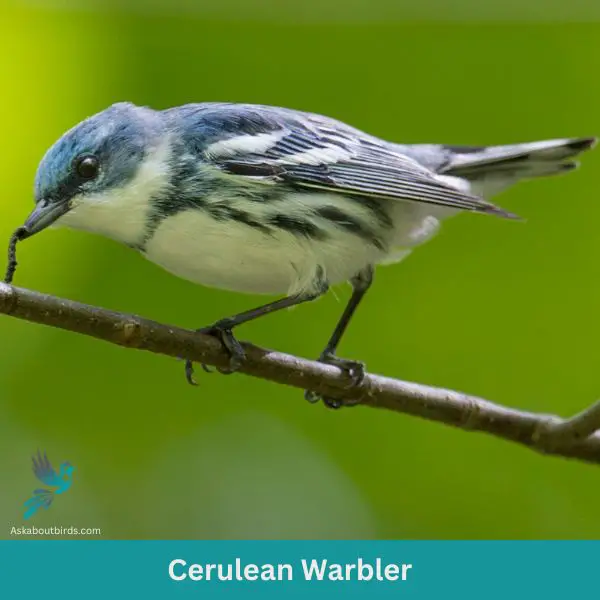
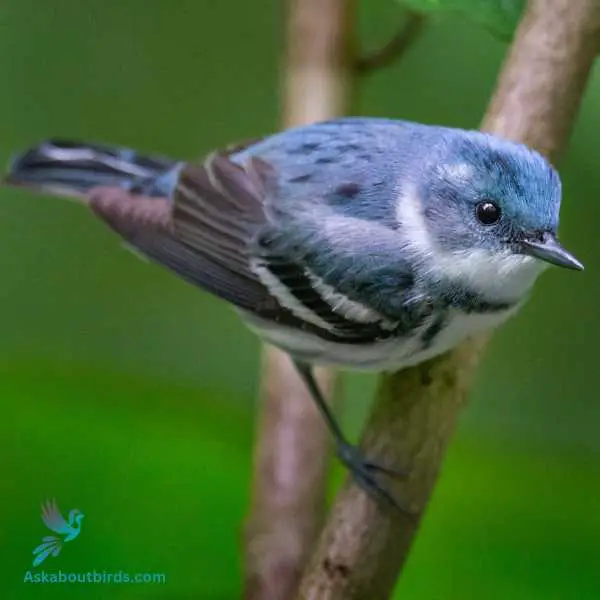
| Trait | Cerulean Warbler |
|---|---|
| Scientific Name | Setophaga cerulea |
| Length | 4.5 inches |
| Wingspan | 7.9-8.7 inches |
| Weight | 0.3-0.4 ounces |
The Cerulean Warbler is a striking songbird known for its sky-blue plumage and flitting movements in the forest canopy.
Appearance: Males boast a vibrant cerulean blue color on their upperparts, with streaked underparts, and a black necklace. Females have a more subdued bluish-green hue and lack the prominent black markings seen in males.
Diet: The diet of the Cerulean Warbler is predominantly made up of insects and spiders. They actively forage high in the treetops, gracefully maneuvering through leaves and branches.
Reproduction: Cerulean Warblers nest in the upper branches of tall deciduous trees. The female weaves a shallow cup-shaped nest and lays a clutch of 3-5 eggs.
Cliff Swallow
Scientific Name: Petrochelidon pyrrhonota
Length: 5-6 inches
Wingspan: 11-13 inches
Weight: 0.8-1.0 oz
The Cliff Swallow is recognized for its square-tipped tail and colony-based nesting habits, often under eaves or on cliffs.
Appearance: Cliff Swallows have a striking appearance with a blue-black back, pale underparts, and a characteristic dark reddish-brown face and throat. A pale, orangish rump and a creamy forehead further distinguish them.
Diet: Mainly insectivorous, Cliff Swallows feed on a variety of flying insects, including beetles, flies, and winged ants. They capture their prey in mid-air, often flying in large, swift groups.
Reproduction: Notably, Cliff Swallows are colonial birds that build gourd-shaped mud nests, usually under eaves, bridges, or on cliff faces. A unique feature among wild birds is their construction of these nests in tight clusters. The female typically lays a clutch of 3 to 6 eggs, which are white with small brown spots.
Little Blue Heron
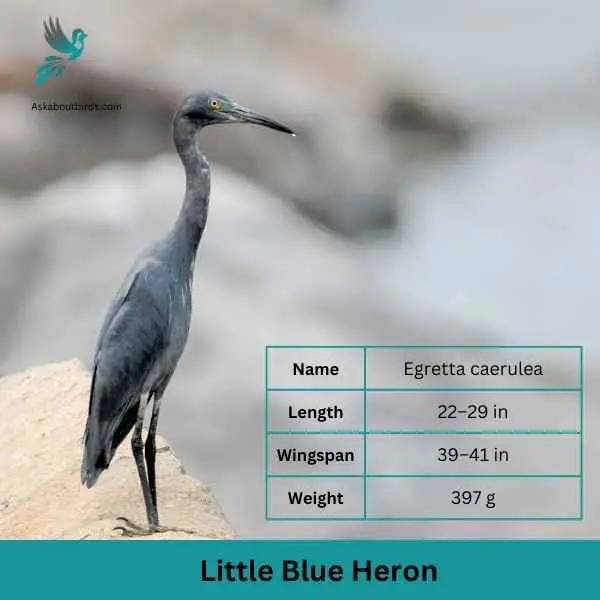
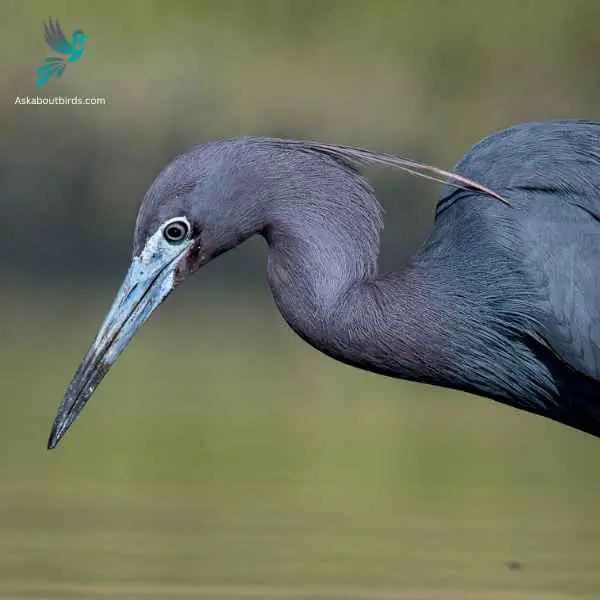
| Feature | Measurement |
|---|---|
| Scientific Name | Egretta caerulea |
| Length | 22–29 in |
| Wingspan | 39–41 in |
| Weight | 397 g |
The Little Blue Heron is a slender and elegant wading bird, often seen foraging in freshwater or saltwater habitats, especially in the southeastern parts of the United States.
Appearance: This heron undergoes a fascinating color transition as it matures. Juvenile Little Blue Herons are white, but they gradually acquire the slate-blue plumage that characterizes adults. The adult has a dark blue-gray body with a purplish neck and head. Their bill is grayish with a black tip.
Diet: The diet of the Little Blue Heron consists mainly of small fish, but they also feed on crustaceans, insects, and other small aquatic animals. Using stealth, they slowly stalk their prey in shallow waters before striking with their long, sharp bill.
Reproduction: Little Blue Herons nest in colonies, often with other wading birds. They build platform nests in trees or shrubs close to water bodies. The female typically lays a clutch of 3 to 5 pale blue eggs. Both parents participate in incubation and feeding the chicks once they hatch.
Blue-gray Gnatcatcher
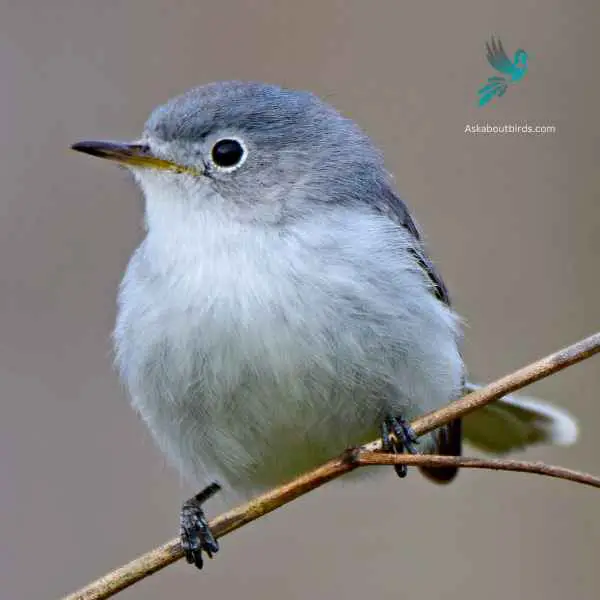
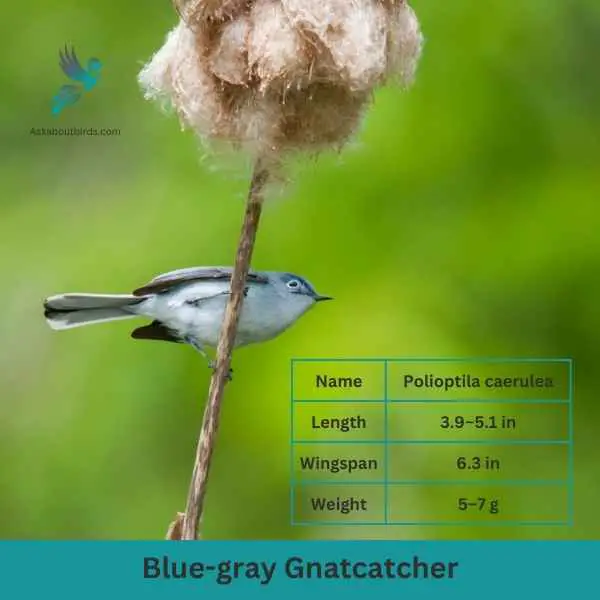
| Feature | Measurement |
|---|---|
| Scientific Name | Polioptila caerulea |
| Length | 3.9–5.1 in |
| Wingspan | 6.3 in |
| Weight | 5–7 g |
The Blue-gray Gnatcatcher is a petite, active bird, frequently observed flitting about treetops, emitting its distinctive high-pitched calls as it moves agilely through the branches.
Appearance: This bird exhibits a predominantly blue-gray plumage with a subtle white eye ring and long, slender tail feathers. The tail has distinctive black and white edging, with the males sometimes showing a faint black line on their forehead during the breeding season.
Diet: Blue-gray Gnatcatchers primarily feed on small insects and spiders. They’re adept hunters, foraging actively among foliage and even catching insects in mid-air.
Reproduction: These birds weave compact, cup-shaped nests on tree branches using plant materials, spider webs, and lichen. The exterior of the nest often matches the tree bark, making it well camouflaged. Inside, the female lays a clutch of 3 to 5 blue or greenish eggs, which she incubates.
Where to Spot Louisiana’s Blue Birds
Louisiana, with its diverse habitats, is a paradise for birdwatchers, especially those interested in blue birds. Here are some of the best spots in the state known for their great diversity of bird species:
- Atchafalaya National Wildlife Refuge: Located in the heart of the largest river swamp in North America, this refuge is home to over 250 bird species, making it an excellent spot for birdwatching, especially for those looking to spot blue birds and other waterfowl.
- Creole Nature Trail: Also known as Louisiana’s Outback, this is one of the best places to spot coastal bird species in the state. The trail offers a variety of habitats including marshes, prairies, and beaches, all of which attract a diverse range of birds.
- Barataria Preserve (Jean Lafitte National Historical Park and Preserve): This preserve offers a mix of marsh, swamp, and forest habitats that are home to a wide variety of bird species. The boardwalk trails provide an excellent opportunity for birdwatching.
- Grand Isle: Located on the Gulf of Mexico, Grand Isle is a barrier island that serves as an important stopover for migratory birds, making it a great spot for birdwatching during migration seasons.
- Kisatchie National Forest: This is the only national forest in Louisiana and offers a diverse range of habitats. The pine forests in this area are home to many bird species, making it an excellent spot for birdwatching all year round.
| Neighboring State | Best Spots to See a Wide Range of Blue Birds |
|---|---|
| Texas’s Blue birds | 1. Big Bend National Park 2. Guadalupe Mountains National Park 3. Aransas National Wildlife Refuge |
| Arkansas’s Blue birds | 1. Hot Springs National Park 2. Buffalo National River 3. Ouachita National Forest |
| Mississippi’s Blue birds | 1. Noxubee National Wildlife Refuge 2. Gulf Islands National Seashore 3. DeSoto National Forest |
FAQs on Blue Bird Species Found in Louisiana
What is the difference between male Indigo Buntings and other blue birds?
Male Indigo Buntings are one of the most brightly colored birds in North America. During the breeding season, the males have a brilliant, almost iridescent, blue plumage that makes them stand out. Unlike other blue birds, like the Eastern Bluebird, which has a blue back and a white belly, the male Indigo Bunting is blue all over, except for a few black wings and tail feathers. Additionally, Indigo Buntings do not have any white wing bars, which are present in some other blue bird species. This bright blue coloring, along with their song, helps male Indigo Buntings attract a mate during the breeding season.
Do house finches visit bird feeders?
Yes, house finches are common backyard birds that frequently visit bird feeders. They are particularly fond of sunflower seeds, and black oil sunflower seeds are a particular favorite. House finches are small birds with a reddish-brown coloration, a white belly, and streaked underparts. Male house finches have a bright red patch on their head and throat. If you want to attract house finches to your backyard, consider putting up a bird feeder with sunflower seeds. They will also eat other seeds, fruits, and insects.
How to identify European Starlings?
European starlings are medium-sized birds with iridescent black plumage, which can have a green or purple sheen depending on the light. They have a long bill, which is yellow during the breeding season and dark at other times of the year. In flight, their black wings are short and pointed, and they display white spots on their feathers during the winter months. Their legs are reddish-pink. Juveniles are pale gray before they get their adult plumage. European starlings can mimic the calls of other bird species and also make a variety of other noises which makes these birds interesting.
Are dead trees useful for any bird species?
Yes, dead scattered trees, also known as snags, are incredibly important for a variety of bird species. They provide nesting sites for cavity-nesting birds like woodpeckers, nuthatches, and chickadees. The decaying wood is also a habitat for insects, which serve as a food source for birds that only eat insects, mostly insects. Additionally, dead trees provide perching sites for birds of prey like hawks and eagles. So, while they might not be the most aesthetically pleasing, dead trees play a crucial role in the ecosystem and are beneficial for many bird species.
